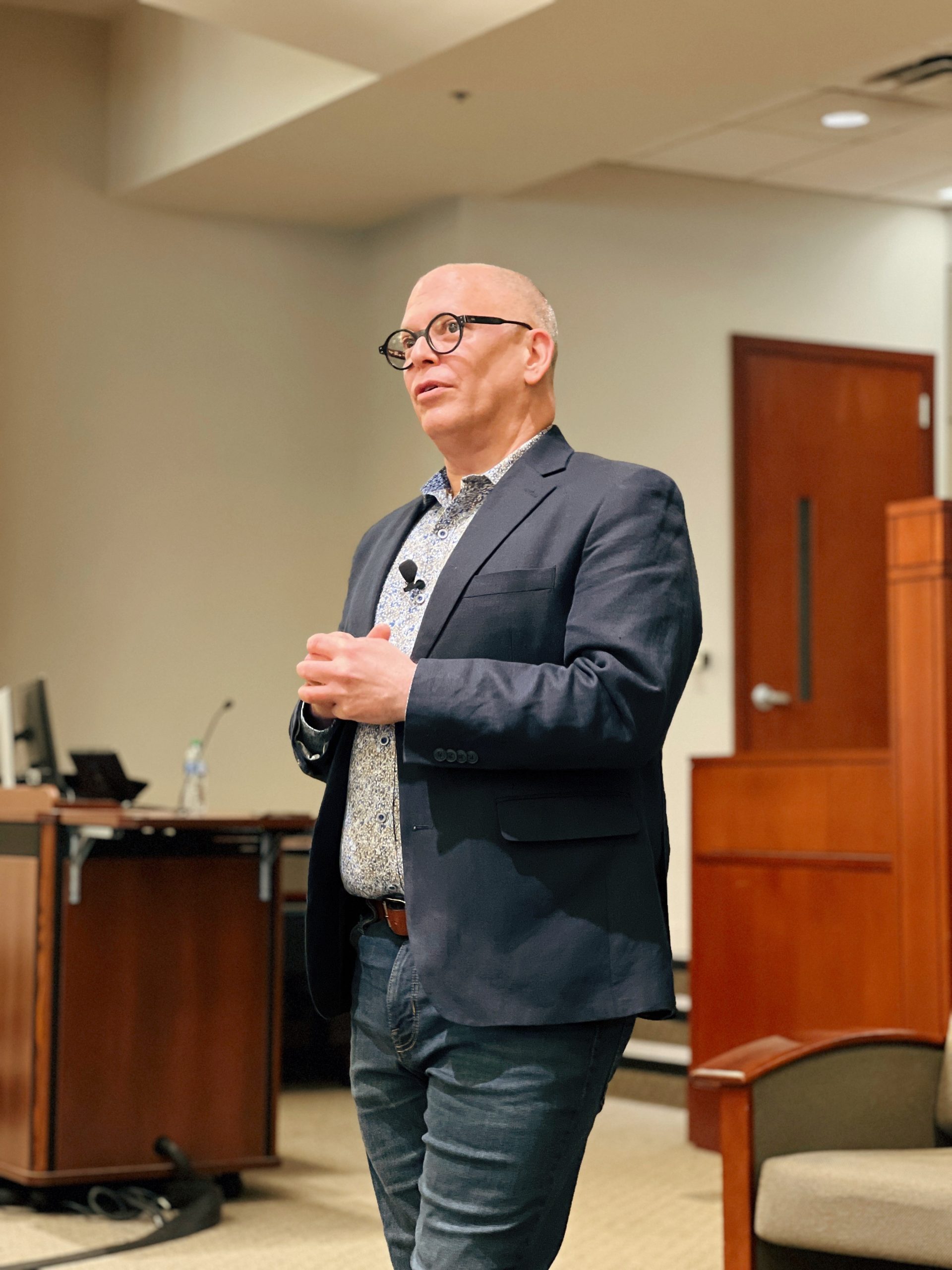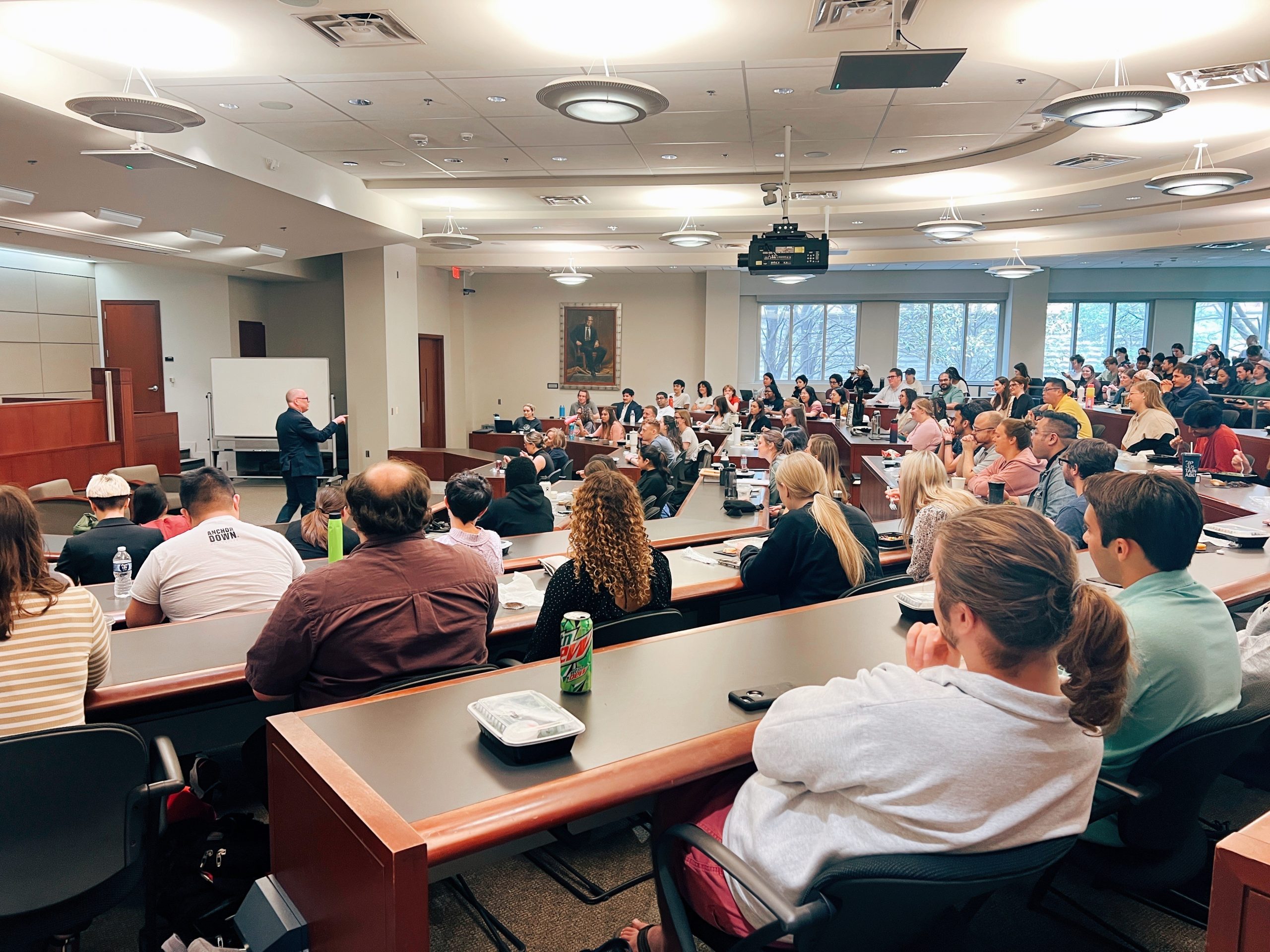by Corey Feuer
Before he was 10 years old, Jim Obergefell knew he was gay. “I knew I was different,” he told a packed Flynn Auditorium, “but I also knew from society that that was wrong.”
 Obergefell spoke about how this societal stigma drove him towards a life of civil right activism at a talk presented by the Hyatt Student Activities Fund. During the event, entitled “Love Wins – An Open Conversation with Jim Obergefell”, he narrated the love story that would ultimately lead to Obergefell v. Hodges (2015), the landmark Supreme Court case that made same-sex marriage legal nationwide.
Obergefell spoke about how this societal stigma drove him towards a life of civil right activism at a talk presented by the Hyatt Student Activities Fund. During the event, entitled “Love Wins – An Open Conversation with Jim Obergefell”, he narrated the love story that would ultimately lead to Obergefell v. Hodges (2015), the landmark Supreme Court case that made same-sex marriage legal nationwide.
He started dating his boyfriend John Arthur in the early 1990s, eventually living together in Cincinnati. Marriage crossed their minds, but same sex unions were not recognized in their home state of Ohio.
“We wanted to make those commitments,” Obergefell recalled, “but we didn’t want to have just a symbolic ceremony.”
Arthur was diagnosed with Amyotrophic Lateral Sclerosis (ALS), a fatal neurodegenerative disease, in 2012 and required in-home hospice care by April 2013. Arthur’s decline coincided with a major Supreme Court decision that changed their thoughts on marriage.
“On June 26, 2013, John called me into his room because there was news coming out from the Supreme Court,” Obergefell told the audience. “So, I’m standing next to this bed holding his hand as we hear the news that in the decision in United States v. Windsor, the Supreme Court struck down the Defense of Marriage Act.”
The decision against DOMA meant that for the first time, Obergefell and Arthur could have a marriage recognized at some level by the government while living in Ohio. The state would still not recognize their union, but the federal government would.
“As the news was sinking in, I realized that this was the first time in our almost 21 years together that we could get married and actually have it mean something, at least to the federal government,” Obergefell recalled.
With the financial support of his family and friends, Obergefell chartered a jet to Maryland, and they wed in July 2013 in a ceremony held on the landed plane.
“It changed everything,” said Obergefell of the wedding. “It changed how we felt about each other. It changed how we felt about our relationship. It changed how we felt in the eyes of our government.”
 Obergefell never intended to become an activist. Just a few days after the wedding, however, he was introduced through mutual friends to civil rights attorney Al Gerhardstein, who informed the couple that when Arthur died, Obergefell would not be listed as his spouse on his death certificate.
Obergefell never intended to become an activist. Just a few days after the wedding, however, he was introduced through mutual friends to civil rights attorney Al Gerhardstein, who informed the couple that when Arthur died, Obergefell would not be listed as his spouse on his death certificate.
“John and I knew Ohio wouldn’t recognize our marriage,” Obergefell clarified, “but that was abstract. This death certificate made that abstract understanding into something real, something harmful, something hurtful.”
Gerhardstein convinced the couple to file a suit in the United States District Court for the Southern District of Ohio just eight days after they wed. Their argument in court was that other types of marriages not legal to perform in Ohio were still recognized by the state if they were performed legally in a different jurisdiction.
“In Ohio,” Obergefell explained, “an underage couple cannot get a marriage license or get married. However, if there’s an underage couple or first cousins in another state where it is legal to get a marriage license and get married, as soon as they cross the border into Ohio, Ohio said ‘we see you, you exist, your marriage gets all the same rights, protections, dignity, and benefits as any other marriage.’”
According to Gerhardstein, this proved that gay people were being treated as a separate class of citizens. The judge assigned to the case, District Judge Timothy Black, agreed and ruled in favor of the couple. The state of Ohio promptly appealed the decision to the United States Court of Appeals for the Sixth Circuit and won, reversing Black’s ruling. The case’s next stop was the Supreme Court, where it was consolidated with five other lower court cases to form Obergefell v. Hodges.
Obergefell was determined to be present in the Court the day his case was argued, waiting on the sidewalk outside the courthouse to make sure he could get a seat. He recalled one of his favorite moments from oral arguments:
“One of the justices brought up the same old argument: ‘You people fighting for marriage equality, you’re trying to redefine marriage. You’re trying to redefine this. It’s meant the exact same thing for millennia. You’re just trying to change that definition.’ Ruth Bader Ginsburg jumped right in and said, ‘No, I’m sorry. We already have redefined marriage because women are no longer the property of their husbands.’”
Obergefell waited two months for the case to be decided. Starting in mid-June, every time the Court announced it would release decisions, Obergefell made sure he was in the courtroom. On June 26, 2015 – the anniversary of Windsor as well as the landmark gay rights case Lawrence v. Texas – the Court held that gay couples had the constitutional right to marry.
“I burst into tears,” Obergefell recalled excitedly. “You could hear people sobbing in the courtroom. Al told me later that he had never seen so many attorneys crying in court.”
Arthur did not live to see the decision – he died in 2013 – but Obergefell thought of him that day.
“My first reaction when it sunk in that we won was ‘John, I wish you were here. I wish you could be part of this. I wish you could know our marriage can never be erased.’”
Obergefell is still involved in civil rights advocacy and politics today. Looking back on Obergefell nearly eight years later, Obergefell told the audience that there was still a lot of work to do.
“The transgender community is targeted everywhere,” he said. “Drag is being targeted. Books are being banned.”
Despite all this, however, Obergefell is staying optimistic.
“What gives me hope is speaking in front of young people like you and people younger than you,” he said. “They don’t see differences [in people] the way old people like me do. And that’s what gives me hope. That’s what I will keep fighting for.”